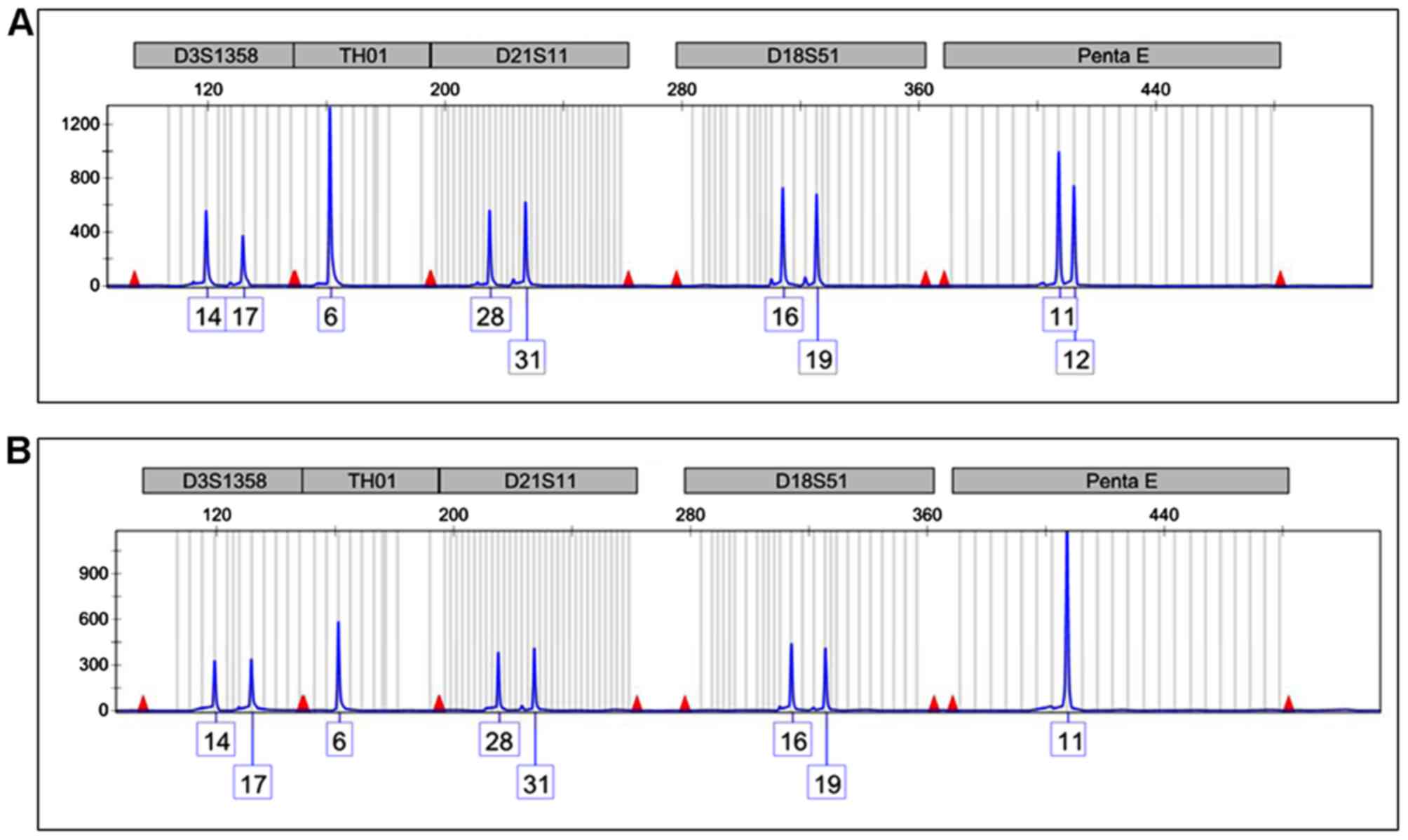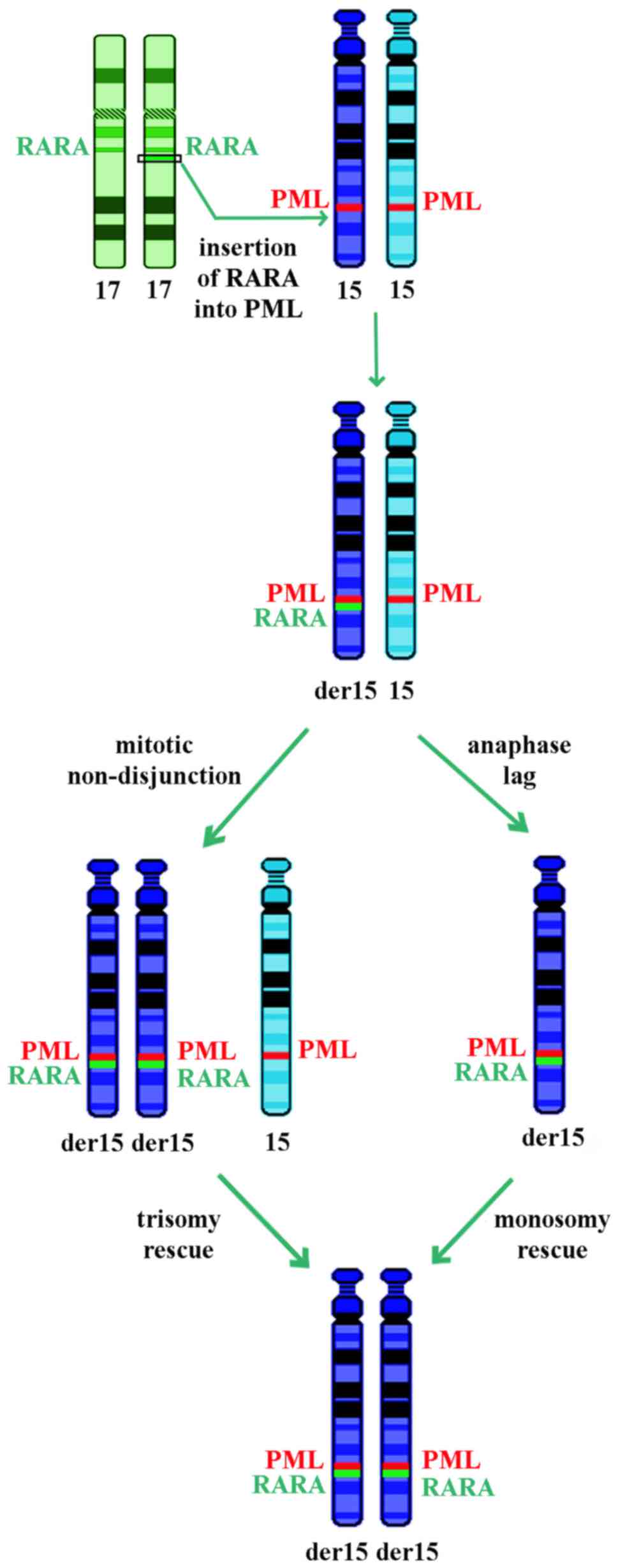|
1
|
Lo Coco F, Nervi C, Avvisati G and
Mandelli F: Acute promyelocytic leukemia: A curable disease.
Leukemia. 12:1866–1880. 1998. View Article : Google Scholar : PubMed/NCBI
|
|
2
|
Kadam PR, Merchant AA and Advani SH:
Cytogenetic findings in patients with acute promyelocytic leukemia
and a case of cml blast crisis with promyelocytic proliferation.
Cancer Genet Cytogenet. 50:109–117. 1990. View Article : Google Scholar : PubMed/NCBI
|
|
3
|
Bapna A, Nair R, Tapan KS, Nair CN, Kadam
P, Gladstone B and Advani SH: All-trans-retinoic acid (ATRA):
Pediatric acute promyelocytic leukemia. Pediatr Hematol Oncol.
15:243–248. 1998. View Article : Google Scholar : PubMed/NCBI
|
|
4
|
Advani SH, Nair R, Bapna A, Gladstone B,
Kadam P, Saikia TK, Parekh PM, Gopal R and Nair CN: Acute
promyelocytic leukemia: All-trans retinoic acid (ATRA) along with
chemotherapy is superior to ATRA alone. Am J Hematol. 60:87–93.
1999. View Article : Google Scholar : PubMed/NCBI
|
|
5
|
Burnett AK, Grimwade D, Solomon E,
Wheatley K and Goldstone AH: Presenting white blood cell count and
kinetics of molecular remission predict prognosis in acute
promyelocytic leukemia treated with all-trans retinoic acid: Result
of the Randomized MRC Trial. Blood. 93:4131–4143. 1999.PubMed/NCBI
|
|
6
|
Amare PS, Baisane C, Saikia T, Nair R,
Gawade H and Advani S: Fluorescence in situ hybridization: A highly
efficient technique of molecular diagnosis and prediction for
disease course in patients with myeloid leukemias. Cancer Genet
Cytogenet. 131:125–134. 2001. View Article : Google Scholar : PubMed/NCBI
|
|
7
|
Brockman SR, Paternoster SF, Ketterling RP
and Dewald GW: New highly sensitive fluorescence in situ
hybridization method to detect PML/RARA fusion in acute
promyelocytic leukemia. Cancer Genet Cytogenet. 145:144–151. 2003.
View Article : Google Scholar : PubMed/NCBI
|
|
8
|
Mistry AR, Pedersen EW, Solomon E and
Grimwade D: The molecular pathogenesis of acute promyelocytic
leukaemia: Implications for the clinical management of the disease.
Blood Rev. 17:71–97. 2003. View Article : Google Scholar : PubMed/NCBI
|
|
9
|
Park TS, Kim JS, Song J, Lee KA, Yoon S,
Suh B, Lee JH, Lee HJ, Kim JK and Choi JR: Acute promyelocytic
leukemia with insertion of PML exon 7a and partial deletion of exon
3 of RARA: A novel variant transcript related to aggressive course
and not detected with real-time polymerase chain reaction analysis.
Cancer Genet Cytogenet. 188:103–107. 2009. View Article : Google Scholar : PubMed/NCBI
|
|
10
|
Swerdlow SH, Campo E, Harris NL, Jaffe ES,
Pileri SA, Stein H, Thiele J and Vardiman JW: WHO Classification of
Tumours of Haematopoietic and Lymphoid Tissues. 4th Edition. IARC;
Lyon: 2008
|
|
11
|
Tirado CA, Jahn JA, Scheerle J, Eid M,
Meister RJ, Christie RJ, Croft CD, Wallingford S, Heritage DW,
Mowrey PN and Meloni-Ehrig AM: Variant acute promyelocytic leukemia
translocation (15;17) originating from two subsequent balanced
translocations involving the same chromosomes 15 and 17 while
preserving the PML/RARA fusion. Cancer Genet Cytogenet. 161:70–73.
2005. View Article : Google Scholar : PubMed/NCBI
|
|
12
|
Wang HY, Ding J, Vasef MA and Wilson KF: A
bcr3/short form PML-RARalpha transcript in an acute promyelocytic
leukemia resulted from a derivative chromosome 17 due to
submicroscopic insertion of the PML gene into the RARalpha locus.
Am J Clin Pathol. 131:64–71. 2009. View Article : Google Scholar : PubMed/NCBI
|
|
13
|
Goldschmidt N, Yehuda-Gafni O, Abeliovich
D, Slyusarevsky E and Rund D: Interstitial insertion of RARα gene
into PML gene in a patient with acute promyelocytic leukemia (APL)
lacking the classic t(15;17). Hematology. 15:332–337. 2010.
View Article : Google Scholar : PubMed/NCBI
|
|
14
|
Kim MJ, Cho SY, Kim MH, Lee JJ, Kang SY,
Cho EH, Huh J, Yoon HJ, Park TS, Lee WI, et al: FISH-negative
cryptic PML-RARA rearrangement detected by long-distance polymerase
chain reaction and sequencing analyses: A case study and review of
the literature. Cancer Genet Cytogenet. 203:278–283. 2010.
View Article : Google Scholar : PubMed/NCBI
|
|
15
|
Lewis C, Patel V, Abhyankar S, Zhang D,
Ketterling RP, McClure RF and Persons DL: Microgranular variant of
acute promyelocytic leukemia with normal conventional cytogenetics,
negative PML/RARA FISH and positive PML/RARA transcripts by RT-PCR.
Cancer Genet. 204:522–523. 2011. View Article : Google Scholar : PubMed/NCBI
|
|
16
|
Welch JS, Westervelt P, Ding L, Larson DE,
Klco JM, Kulkarni S, Wallis J, Chen K, Payton JE, Fulton RS, et al:
Use of whole-genome sequencing to diagnose a cryptic fusion
oncogene. JAMA. 305:1577–1584. 2011. View Article : Google Scholar : PubMed/NCBI
|
|
17
|
Amare PK, Baisane C, Nair R, Menon H,
Banavali S, Kabre S, Gujral S and Subramaniam P: Characterization
of cryptic rearrangements, deletion, complex variants of PML, RARA
in acute promyelocytic leukemia. Indian J Hum Genet. 17:54–58.
2011. View Article : Google Scholar : PubMed/NCBI
|
|
18
|
Koshy J, Qian YW, Bhagwath G, Willis M,
Kelley TW and Papenhausen P: Microarray, gene sequencing, and
reverse transcriptase-polymerase chain reaction analyses of a
cryptic PML-RARA translocation. Cancer Genet. 205:537–540. 2012.
View Article : Google Scholar : PubMed/NCBI
|
|
19
|
Gruver AM, Rogers HJ, Cook JR, Ballif BC,
Schultz RA, Batanian JR, Fesler MJ and Tubbs RR: Modified
array-based comparative genomic hybridization detects cryptic and
variant PML-RARA rearrangements in acute promyelocytic leukemia
lacking classic translocations. Diagn Mol Pathol. 22:10–21. 2013.
View Article : Google Scholar : PubMed/NCBI
|
|
20
|
Blanco EM, Curry CV, Lu XY, Sarabia SF,
Redell MS, Lopez-Terrada DH and Roy A: Cytogenetically cryptic and
FISH-negative PML/RARA rearrangement in acute promyelocytic
leukemia detected only by PCR: An exceedingly rare phenomenon.
Cancer Genet. 207:48–49. 2014. View Article : Google Scholar : PubMed/NCBI
|
|
21
|
Fan H, Ortega V, Fanasch HM, Wang Y,
Holder KN, Higgins RA, Mendiola C, Mohamed G, Vadlamudi K and
Velagaleti G: PML-RARA fusion resulting from a cryptic insertion of
RARA gene into PML gene without the reciprocal RARA-PML fusion:
Clinical, cytogenetic and molecular characterization and prognosis.
Eur J Haematol. 93:354–358. 2014. View Article : Google Scholar : PubMed/NCBI
|
|
22
|
Shepshelovich D, Oniashvili N, Parnes D,
Klein A, Muchtar E, Yeshaya J, Aviram A, Rabizadeh E and Raanani P:
Acute promyelocytic leukemia with isochromosome 17q and cryptic
PML-RARA successfully treated with all-trans retinoic acid and
arsenic trioxide. Cancer Genet. 208:575–579. 2015. View Article : Google Scholar : PubMed/NCBI
|
|
23
|
Tallman MS, Andersen JW, Schiffer CA,
Appelbaum FR, Feusner JH, Woods WG, Ogden A, Weinstein H, Shepherd
L, Willman C, et al: All-trans retinoic acid in acute promyelocytic
leukemia: long-term outcome and prognostic factor analysis from the
North American Intergroup protocol. Blood. 100:4298–4302. 2002.
View Article : Google Scholar : PubMed/NCBI
|
|
24
|
Adès L, Guerci A, Raffoux E, Sanz M,
Chevallier P, Lapusan S, Recher C, Thomas X, Rayon C, Castaigne S,
et al: Very long-term outcome of acute promyelocytic leukemia after
treatment with all-trans retinoic acid and chemotherapy: The
European APL Group experience. Blood. 115:1690–1696. 2010.
View Article : Google Scholar : PubMed/NCBI
|
|
25
|
Lo-Coco F, Avvisati G, Vignetti M, Breccia
M, Gallo E, Rambaldi A, Paoloni F, Fioritoni G, Ferrara F, Specchia
G, et al: Front-line treatment of acute promyelocytic leukemia with
AIDA induction followed by risk-adapted consolidation for adults
younger than 61 years: Results of the AIDA-2000 trial of the GIMEMA
Group. Blood. 116:3171–3179. 2010. View Article : Google Scholar : PubMed/NCBI
|
|
26
|
Iland HJ, Bradstock K, Supple SG, Catalano
A, Collins M, Hertzberg M, Browett P, Grigg A, Firkin F, Hugman A,
et al: All-trans-retinoic acid, idarubicin, and IV arsenic trioxide
as initial therapy in acute promyelocytic leukemia (APML4). Blood.
120:1570–1580, quiz 1752. 2012. View Article : Google Scholar : PubMed/NCBI
|
|
27
|
Burnett AK, Russel NH, Hills RK, Bowen D,
Kell J, Knapper S, Morgan YG, Lok J, Grech A, Jones G, et al:
Arsenic trioxide and all-trans retinoic acid treatment for acute
promyelocytic leukaemia in all risk groups (AML17): Results of a
randomised, controlled, phase 3 trial. Lancet Oncol. 16:1295–1305.
2015. View Article : Google Scholar : PubMed/NCBI
|
|
28
|
Ledbetter DH and Engel E: Uniparental
disomy in humans: Development of an imprinting map and its
implications for prenatal diagnosis. Hum Mol Genet 4 Spec.
1757–1764. 1995. View Article : Google Scholar
|
|
29
|
Liher T: Cytogenetic contribution to
uniparental disomy (UPD). Mol Cytogenet. 3:82010. View Article : Google Scholar : PubMed/NCBI
|
|
30
|
Bennett JM, Catovsky D, Daniel MT,
Flandrin G, Galton DA, Gralnick HR and Sultan C: Proposals for the
classification of the acute leukaemias. French-American-British
(FAB) co-operative group. Br J Haematol. 33:451–481. 1976.
View Article : Google Scholar : PubMed/NCBI
|
|
31
|
Barch MJ, Knutsen T and Spurbeck JL: The
AGT cytogenetics laboratory manual. 3rd edition. Lippincott-Raven
Publishers; Philadelphia: 1997
|
|
32
|
Shaffer LG, McGowan-Jordan J and Schmid:
ISCN 2013 An International System for Human Cytogenetic
Nomenclature. Karger Medical and Scientific Publishers; Basel:
2013
|
|
33
|
Spinelli O, Rambaldi A, Rigo F, Zanghì P,
D'Agostini E, Amicarelli G, Colotta F, Divona M, Ciardi C, Coco FL,
et al: Simple, rapid and accurate molecular diagnosis of acute
promyelocytic leukemia by loop mediated amplification technology.
Oncoscience. 2:50–58. 2014. View Article : Google Scholar : PubMed/NCBI
|
|
34
|
Raghavan M, Smith LL, Lillington DM,
Chaplin T, Kakkas I, Molloy G, Chelala C, Cazier JB, Cavenagh JD,
Fitzgibbon J, et al: Segmental uniparental disomy is a commonly
acquired genetic event in relapsed acute myeloid leukemia. Blood.
112:814–821. 2008. View Article : Google Scholar : PubMed/NCBI
|
|
35
|
Gupta M, Raghavan M, Gale R, Chelala C,
Allen C, Molloy G, Chaplin T, Linch DC, Cazier JB and Young BD:
Novel regions of acquired uniparental disomy discovered in acute
myeloid leukemia. Genes Chromosomes Cancer. 47:729–739. 2008.
View Article : Google Scholar : PubMed/NCBI
|
|
36
|
Mitelman Database of Chromosome
Aberrations and Gene Fusions in Cancer. 2016 Mitelman F, Johansson
B and Mertens F: http://cgap.nci.nih.gov/Chromosomes/MitelmanOctober
6–2016.
|
|
37
|
Stebbing J, Bower M, Syed N, Smith P, Yu V
and Crook T: Epigenetics: An emerging technology in the diagnosis
and treatment of cancer. Pharmacogenomics. 7:747–757. 2006.
View Article : Google Scholar : PubMed/NCBI
|
|
38
|
Schwahn B and Rozen R: Polymorphisms in
the methylenetetrahydrofolate reductase gene: Clinical
consequences. Am J Pharmacogenomics. 1:189–201. 2001. View Article : Google Scholar : PubMed/NCBI
|
|
39
|
Milani L, Gupta M, Andersen M, Dhar S,
Fryknäs M, Isaksson A, Larsson R and Syvänen AC: Allelic imbalance
in gene expression as a guide to cis-acting regulatory single
nucleotide polymorphisms in cancer cells. Nucleic Acids Res.
35:e342007. View Article : Google Scholar : PubMed/NCBI
|












